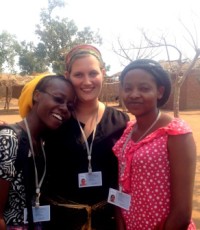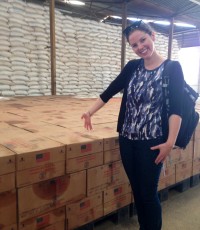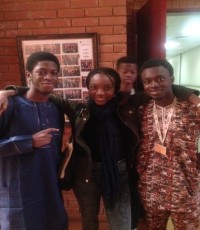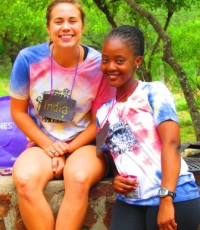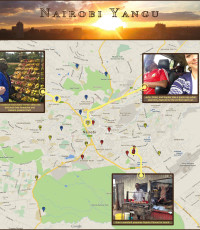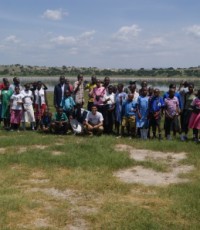January - February 2015
Dear Friends,
Happy 2015! Here at PiAf, the beginning of the new year coincides with a vital part of our fellowship recruitment process: interviews and placements! This year, we interviewed more than 180 candidates for this upcoming year’s 45-50 fellowship posts. As always, we were thrilled to meet such bright, talented and passionate recent college graduates eager to spend a year of service in Africa. We’re looking forward to starting the rolling placement process and matching these young leaders with our diverse partner organizations over the next several months. Thanks so much to all of the dedicated PiAf board members and alumni who took time out of their busy schedules to help with interviews this month – we couldn’t do it all without your ongoing commitment and support!
While we continue to work on selecting next year’s fellowship class, this year’s fellowship class is still as busy as ever on the African continent. Whether it’s teaching students about environmental conservation in Uganda or running a summer camp for HIV-positive adolescents in Botswana, our Fellows continue to make an impact on the ground in Africa, building a commitment to their work and to the continent that will last a lifetime.
We hope you enjoy this edition of the Fellows Flyer!
Warm regards,
Katie Henneman
Executive Director
PiAf Connections
Please click below to check out pictures of our Fellows, Alums and other members of the PiAf family meeting up at home and around Africa.
Attachments
Notes from the Field
By Laura Courbois, 2014-15 Fellow with Imani Development in Malawi
It might be because I come from Minnesota. It might be because I come from a place so cold that winter days hit double-digit negative temperatures and summer days can be horrendously hot. It might be because I come from a place that experiences anything from frozen rain, sleet, blizzards, droughts and tornadoes. Whatever the reason might be, when I first started hearing about Malawi’s infamous rainy season, I wasn’t all that phased. In fact, I was delighted about the idea of replacing torturous Midwest weather with a few rain showers here and there. Little did I anticipate the devastating effects that the rainy season would have on Malawi’s infrastructure, economy, and, most importantly, its people.
This year, Malawi has suffered from the most damaging flood in the history of the country, compelling the President of Malawi to declare a State of Emergency. This comes shortly after media reports that at least 48 people have been killed and nearly 70,000 now find themselves homeless. Moreover, the country’s already fragile infrastructure has taken a toll, as several bridges and roads have been destroyed. Livestock, crops and homes were swept away by floodwaters, leaving thousands of Malawians with nothing.
Worst of all, the rainy season has just begun and is expected to last until March. It’s even more unfortunate that the hardship of one of the poorest countries in the world has barely reached media outlets beyond its borders. Often we hear about large-scale natural disasters and atrocities that are happening globally, while small but equally devastating crises fall below the radar. Perhaps this is because in a country with a serious lack of infrastructure and resources, disasters are expected. The reality is disasters happen every day. However, when you are able to witness firsthand humanity in its rawest form, in the wake of a national struggle for survival against the elements, you are reminded of the very real suffering that accompanies each and every disaster.
“Pray for me.” Those were the last words my housekeeper’s wife spoke to him before the worst rain storm of the season. In the U.S., and in many other developed nations, a rain storm usually means nothing more than an inconvenience – perhaps more traffic on the commute home. For my housekeeper’s family, a rain storm is a matter of life or death. Fortunately, she was able to make it through the storm.
Malawi and other developing countries have thousands of challenges to overcome in order to care for, educate, and protect their people. I never expected rain to be one of them. The world at large may never fully understand the challenges of the Malawian people. Because of this, they may never understand how remarkably resilient they are. Despite it all, Malawi has begun the long and familiar road to recovery. Coming from Minnesota, I feel more and more at home here in Malawi, where I’ve witnessed the same unity and support as in the US, during this critical time of recovery. The country is coming together to rebuild.
Notes from the Field
By Kaitlin Grant, 2014-15 Fellow with UN World Food Programme in Malawi
The first article my mom sent to me upon learning my fellowship placement would be in Malawi with the World Food Programme was a travel piece highlighting the reigning supreme of 90s music in Malawi’s capital city, specifically, the enduring popularity of The Backstreet Boys. Malawi and I, she decided, would be a perfect fit.
Sure enough, in my first weeks in the country, I was encouraged to find that, in fact, my favorite childhood boy band was played in every restaurant, bar, and grocery store in Lilongwe. I was quite surprised, months later to find myself 2 hours from the nearest commercial center, in the mountains of Chiradzulu on route to visit a health centre, to hear “Quit Playing Games with my Heart” siren call across the radio airwaves and proceed to unite my WFP team in a heartfelt, if slightly off-key, rendition.
It only seems natural to use the Backstreet Boys as a lens for reflecting on my PiAf experience in Malawi, thus far.
Black & Blue:
My wardrobe upon moving to Malawi was built around the monochromatic sartorial staples of Washington, DC. Navy, black, cream, and more navy. Chitenge (the vibrant printed fabric popular in Malawi) has reintroduced a welcome dose of color into my life.
All I Have to Give:
The past few months have been truly eye-opening for me into “traditional” humanitarian assistance and the movement of many humanitarian actors, from relief to building resilience and capacity. I appreciate working for an organization that is eager to expand beyond its historical niche of food distribution within emergency contexts, to collaborate with other actors to better equip, prepare, and work alongside communities in a holistic response toward food security.
Show Me the Meaning of Being Lonely:
Something that I was especially mindful of upon moving here was the importance of building community. For me, this was the first time in my life that I moved to a country where, upon arrival, I did not know a single person. I am so grateful to have plugged into a lively community – complete with trivia nights, Afro-pop dance classes, family dinners with former PiAf Fellows, and many lake trip adventures. Beyond the social fabric of Lilongwe, having a supportive network of PiAf Fellows has also been an invaluable resource for tips, advice, and inspiration.
Notes from the Field
By Rebecca Merrifield, 2014-15 Fellow with The Rwanda School Project in Rwanda
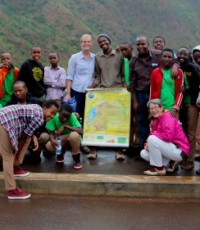
Becca (center left, in a light blue shirt) accompanying S1 students on a field trip to Rusumo Falls to learn about hydroelectricity.
After six months of living in Rwanda, I feel as though it has truly become my home, and I have even developed a little Rwandan pride, which I’ve shared below:
Top Ten Reasons Rwanda is the Best:
1. It might just be the safest place in Africa (definitely in East Africa)
2. Avocadoes and mangoes are everywhere, for a cheap price!
3. Friendly people, who will even return a stolen wallet!
4. Smooth roads—no car sickness! Well, maybe sometimes…
5. Cycling is a popular sport. Go Team Rwanda!
6. The Hills. What doesn’t kill you makes you stronger, right?
7. The cafés in Kigali. And Rwandan Coffee.
8. Beautiful green landscapes.
9. Traditional Rwandan dance—so elegant.
10. Small but mighty!
While I am grateful for these aspects of my life in Rwanda, I am even more grateful for the relationships formed with others and for the knowledge we have shared. At the Rwamagana Lutheran School, I am responsible for developing an environmental studies curriculum geared towards secondary students. I have enjoyed exploring the beautiful natural landscape of Rwanda and learning about the country’s environmental issues, but I most enjoy witnessing how the students appreciate their surrounding environment. Despite the current lack of an environmental studies class, the students amaze me with their knowledge of agriculture, animal husbandry, and climate change. I often think that I have more to learn from them, than they from me!
This leads me to think of Ignace. Ignace is an S5 student who has been attending RLS since it began in 2009. He is an orphan and therefore stays at school during the breaks. But he doesn’t just sit around and watch movies. Ignace is the expert caretaker of the chickens, and also tends to the school garden. When I arrive at school in the morning, I am greeted with a huge, glowing smile as he looks up from the rows of plants. He asks me, “Do you know how to do this in America?” and I just nod and say “Not as well as you!” When it comes to the chickens, Ignace shows me what to feed them to make their yolks so yellow, and he handles them as if they are his own babies. I can’t help but admire the way he cares so much about these creatures and about the land. I know that young people like Ignace are the true leaders who will help Rwanda on its way towards sustainable development. And I can only hope and pray that his kind of stewardship and reverence towards the environment can permeate the rest of the school and local community (while also doing my job, of course!).
Notes from the Field
By Vivian Ojo, 2014-15 Fellow with African Leadership Academy in South Africa
Moving to South Africa to live and work at African Leadership Academy was like a line from one of my favourite poems – “coming home to a place I had never been. A nostalgia for a place I had never seen.”
I was finally at a place that was living proof of a blurry dream that I vaguely recollected. ALA was trying to transform the African continent starting with one young leader at a time. Since I could read the news and independently interpret it, I had never thought there was a sustainable way to transform a culture of broken leadership and oppression in such a vast continent. But when I sit for dry sandwiches with students from each corner of the continent and they see a way to do it, I am quickly brought to my senses. The hope is infectious. It reminds me of the types of fairy-tales that I long stopped believing as I see them coming true before my very eyes. I pick up my skepticism and slip it in my back pocket and reach for something different this time around.
Moving to South Africa to live and work at African Leadership Academy is like a line from one of my favourite poems – “We were made in His image, so call us by our names.”
I am no longer afraid to acknowledge my own excellence. I am not afraid to declare that I am good at some things. Some things that I am purposed for, come naturally to me. Africa has taught me this – I am as I believe I am. The continent that was so torn and brutalized seems to have a permanent smile on its face, seen in the people I meet, the way they dance and the dreams they allow. The continent says to me, you are allowed to be imperfect yet excellent, you are allowed to be loud and heard if you think you know something and even if you don’t. You have permission to try because even though you are made with flaws, you are also made with perfect potential.
Moving to South Africa to live and work at African Leadership Academy is like a line from one of my favourite poems – “Grow where you are planted.”
I finally find myself in a place I never planned to be, extending my roots deep and finding comfort here. I didn’t get the placement I wanted, to be honest. I wanted to be in some exotic part of the continent where people spoke Portuguese or French and bartered in malls safe from the eerie smile of McDonalds. I was thankfully not placed where I wanted to be, but where I needed to be. Here at the African Leadership Academy, I am stretching myself and learning how to adapt to my new size. I am working till 7 or 8 in the evening taking calls and editing college apps from desperate students after that. And I am feeling no grudge for it nor seeking any recognition or pat on the back, because I am so perfectly planted and solidly situated in this new soil that I have found that I take in nutrients from my surroundings.
I have come home to a place I have never been and found people to love and things to do that remind me that I was created in divine image and can excel, not just in spite but because of where I am planted.
Notes from the Field
By Emily India Richter, 2014-15 Fellow with Baylor International Pediatric AIDS Initiative in Botswana
When I tell my friends back at home that I work at a pediatric HIV clinic, the mental image that conjures up for them is much different that my everyday reality. Yes, children die of HIV at the Botswana-Baylor Children’s Clinical Centre of Excellence (COE), but many more live successful, happy, thriving lives. With treatment and proper adherence to medication, most children with HIV can live a “normal” life and progress into adulthood like their HIV-negative counterparts. So instead of picturing the “poor African children with HIV,” I invite you to conjure up an image of laughter, smiles, and more importantly, hope:
Gaborone Teen Club—part of the Teen Club network that comprises the largest support network for adolescents living with HIV (ALHIV) in the world—meets once a month, with attendance ranging from 100 to 200 teens. The need for Teen Club stems from the rising mortality rate of ALHIV; the number of annual deaths caused by HIV is decreasing in all populations globally except for in the adolescent population, where the mortality rate is increasing due mostly to lack of medical adherence.
Together with a group of ten Teen Leaders—Teen Club members elected by their peers to represent Teen Club—my job is to help lessen the weight and power an HIV-positive status holds over our clients through Teen Club. Although Teen Club provides solidarity to ALHIV, a once-monthly event can only offer so much support. In response to the need for a heartier support system to bolster medical adherence, the Teen Leaders proposed we plan a summer camp. With the help of funds raised through an IndieGogo campaign, in addition to local donations, we planned a four-day camp to address the various reasons teens do not take their medication regularly.
Camp Ya Chesa took place from the 14th to the 17th of December at a local nature reserve. Camp participants rotated through three stations a day: an educational lesson, an art activity, and free time. During the day, teens learned strategies to lessen stress, and listened to a guest speaker talk about her experience in a discordant relationship. A local artist presented a two-day workshop on goal setting for 2015, and teens made badges out of bottle caps and local fabric to represent their goals. Free time activities included making friendship bracelets, playing soccer, volleyball or Twister, and hanging out with new friends. Teens also participated in a game drive and Silly Olympics. At night before bed, campers roasted s’mores, told jokes around the campfire, and watched Despicable Me. Most importantly, however, teens at camp took their medication together, twice a day, every single day. For some teens, this was the first time in their life that they had consistently taken their medication independently.
So the next time someone talks about the “children dying of HIV in Africa,” I challenge you to also consider the courage of these adolescents as they transition to adulthood, and the hope that this new generation brings to the HIV epidemic.
Notes from the Field
By Sophia Stylianos, 2014-15 Fellow with Sanergy in Kenya
During the past seven months in Nairobi, I have had the opportunity to explore many of the city’s distinct and diverse corners. After commuting to work at Sanergy in Mukuru, an informal settlement in the Industrial Area, via matatu; celebrating Oktoberfest in the city’s largest urban forest; and testing used cars in more than eight different neighborhoods, my tolerance for traffic has dwindled, my appreciation for “Falling Into You”-era Celine Dion has remained the same*, and my ability to navigate uncharted territories without a smartphone or map has hugely increased.
If you are prepared to eat crisps and plums from street hawkers, dance like everyone is watching, and squeeze yourself between strangers in the back row of the morning bus, I’d like to take you on a tour of Nairobi yangu. My Nairobi. (Click map picture for a closer look.)
Category: Exploration [blue markers]
1. Rosslyn Academy – an international school where I often play pick-up Ultimate Frisbee on Sundays.
2. Karura Forest – an urban forest in which the German Business Association hosted Oktoberfest with live music, lots of beer, and delicious sausages.
3. A104 Nairobi – Nakuru Road – the highway that leads to awesome excursions in Kenya, like Hell’s Gate National Park, Lake Naivasha, and Mt. Suswa.
4. Diamond Plaza – a shopping center with an amazing Indian food court, free Saturday yoga classes, and an indoor rock climbing gym.
5. Treehouse – a bar and club where I danced on stage with Kenya’s number one boy band, Sauti Sol.
6. The Hood Place – the best bar in the world. Period. Doesn’t hurt that it’s a seven-minute walk from my house.
7. Sheldrick Elephant Orphanage – home to Murit, the elephant I adopted for my grandma.
Category: Work [red markers]
8. Ambassadeur Hotel – location of the matatu transfer during my morning commute to work.
9. City Stadium – neighborhood that boasts an incredible used container market (very important for a company that transports human waste throughout a capital city).
10. United Engineering Supplies – hardware store with impeccable customer service and every tool imaginable.
11. Rock Crystal – amazing hole-in-the-wall Indian restaurant. Dirty dishes are carried to and from the kitchen with a basket-rope-pulley system.
12. Simba Cool – an area of Mukuru in which I conducted a user study for an in-home toilet.
13. Kim’s Butcher Shop – home of the best nyama choma in Nairobi.
14. Sanergy Field Office – My office!
15. Wilson Airport – a small airport from which I flew to the Kakuma Refugee Camp for a week of product development research.
Category: Car Search [yellow markers]
After three months of searching for an affordable and reliable used car in Nairobi, I feel confident that I can write a comprehensive Consumers Digest Weekly on the subject. My team – John the cab driver and Peter the mechanic– and I have met sleazy salesmen, learned about leaking radiators, and visited parking lots in each of the following locations and neighborhoods:
16. Valley Arcade Shopping Centre
17. 680 Hotel, Central Business District
18. Buru Buru neighborhood
19. Adam’s Arcade Shopping Centre
20. Madaraka Shopping Centre
21. Pipeline neighborhood
22. Galleria Mall
23. Mlolongo neighborhood
*extremely high
Notes from the Field
By Max Sugarman, 2014-15 Fellow with The Kasiisi Project in Uganda
Every day in western Uganda, an extraordinary palette of experiences can best be described in colors.
Magenta – bright vivid flowers are handed to me as kids shout my pet name, “ATEENYI!” on my commute up the hill to my office. I respond: “Oraire ota,” or “How’s your morning?” sharing in the warmth of my Batooro community, the most joyful place I’ve ever lived in.
Sky Blue – arriving at my office next to Kasiisi Primary School, hundreds of students in bright blue uniforms study and play at the historic core school of our program, one of 14 schools where the Kasiisi Project works. Our goal is to reach out to students who live near Kibale National Forest and use education as a tool to save the forest.
Green – many shades that makes up the forests and farms in my area inspire me to think of creative strategies to communicate conservation to our students. The forest is not simply green, but a verdant multifaceted architecture of towering trees hosting the greatest biodiversity of primates in the world.
Orange – the dust on my clothes after visiting a school to help run an evaluation of our conservation programs. Not only do I help distribute a rigorous set of evaluations to monitor the effectiveness of our programs, but I get an opportunity to organize and analyze this data for our grants.
Gold – crisp shades of brown and yellow filter through the binoculars I share with students and teachers on a field trip to the savannas of Queen Elizabeth National Park. By taking schools to parks for trips, we share the wonders of nature – grand elephants, ferocious crocodiles, elegant cranes – and build an appreciation for nature.
Neon White – inside the dimmed office, I share knowledge with my co-workers on basic computer skills, while they share ideas on how to apply these skills to their work on community health and education. While it might be faster to compile data on my own, I find it far more rewarding to collaborate with my Ugandan counterparts and share these technical capacities.
Crimson – the color of Harvard University, from which many volunteers arrive to support our organization’s initiatives. While I am a proud University of Washington Husky, I enjoy the opportunity to foster new perspective in our volunteers from around the world and support their ambitions, learning, and growth whether they work on our sustainable farm or encourage social entrepreneurship lessons.
Mud Brown – the rainy season is dominated by dirt as I play Frisbee with a cohort of Ugandans and mzungus in Fort Portal after work.
Lavender – the color of the jacaranda blossoms that fall onto the roads at the school or into the beautiful crater lakes that I can swim in on a rare hot day. From the snowcapped Rwenzoris to the rolling hillsides and bamboo forests, the natural beauty of Western Uganda is unique to the world, and a marvelous escape after a week’s hard work.





